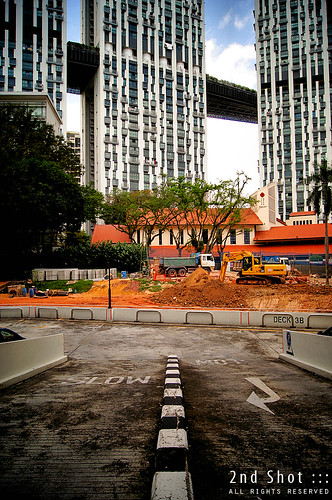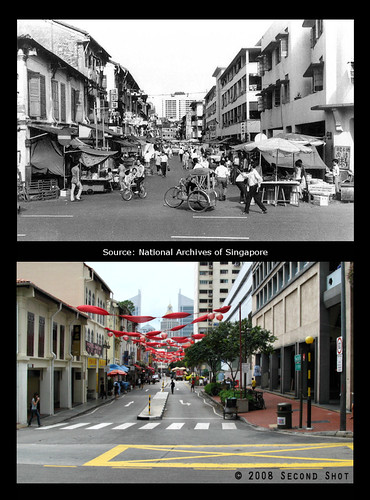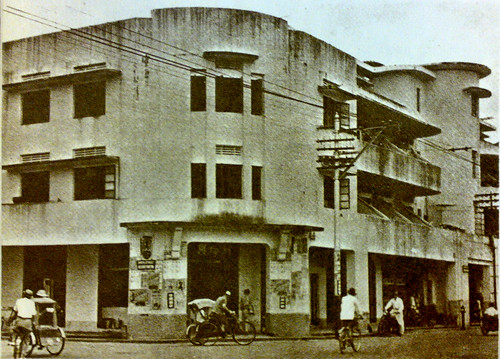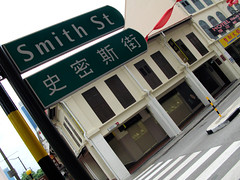Pages
Jan 19, 2012
Oldest Surviving Public Pool Bites the Dust
After I was relocated to Sepoy Lines last April for my work project, Chinatown became one of my many lunchtime playgrounds. There were times I walked to Yan Kit Road, to try out the food centre and coffee shops at Tanjong Pagar Plaza. It was an never-ending discovery, as I would try out a new eating place each day, never to repeat the same shop later. In this latest adventure, I found out at last where the nasi biryani stall from Tanjong Pagar Railway Station relocated after June 2011. However food is not my topic today.
May 28, 2011
Daily Lunchtime Adventures from Si Pai Por
It has been more than a month since I moved on to my new workplace at Si Pai Por. The location is really convenient; the MRT is literally at my doorstep with the nearest exit a stone's throw away. My commuting time is also shortened and for the first time there is no need for any bus-transfer. While the remuneration and perks are not fantastic, the opportunity, where location is concerned, is a godsend.
May 2, 2010
I Helped Old Ladies Find Their Way in Chinatown!
The incident happened this afternoon at Hong Lim Complex. I was about to cross over to China Square Central when a middle-age voice asked the group of youths behind me for direction. The inquiry was done in Mandarin. The youths, also Mandarin-speaking, were clueless about her destination. I was already halfway up the stairs to the overhead bridge (see cover photo) but chivalry got the better of me. Determined to save the damsels in distress (old ladies, not the youths), I rose to the occasion. What was the inquiry?
Dec 28, 2008
2nd Shot: Junction of Smith Street and New Bridge Road
Source is a 1960 photo and my second shot was taken on the morning of March 2, 2008. You can see Chinese New Year decorations leftover from the festive season a month before.
The scene of the 1960 Smith Street is pretty comical actually. It is like a standoff between the old and the modern. On the left you have those dingy shophouses with wooden creaky windows and walls in need of a paint job; on the right the stylish flats stand stoutly with their whitewashed walls. They stare across at each other with their eyes, the windows. If we agree that the pace of development accelerated in the 1960s, then the standoff can be likened to a struggle in post-independence Singapore - will the old make way for the new? Who will outlive the rest?
Residents of the shophouses in 1960 Smith Street would be surprised to find the flats opposite gone in 2008. Their own houses, interior modernised and facade preserved, are still staring defiantly across the street.
**********
What got me interested in a second shot was the foreground building on the right. You may not recognize this nondescript building in the 1960 photo, but what if I were to show you this?
This famous photo, reproduced in history textbooks, will be familiar to those who paid a little more attention during their history lessons. You will also find it in the exhibition at Old Ford Factory which ordinary guy blogged about here.
This SIT flat was the Kempeitai West District Branch. The infamous YMCA was Kempeitai HQ as well as East District Branch. Because I've not read of any North or South Branch, the West Branch seems very high up in the hierarchy. The Kempeitai commandeered other civilian properties as well, like the White House Hotel at Mayo Street which is now Hotel 81 Rochor.
Here, I share with you some interesting observations. In both old photos, we see similar-sized advertisement plastered on the entrance wall. The one in 1960 shows the big Chinese characters 猪肉粥 (pork porridge), the 'porridge' is especially big judging from the lady in front. Below the advertisement, the wall was painted with a different colour. This colour stripe would be very prominent as it reached chest level, again using the lady as reference. I wonder how the building looked like in colour.
Next, look up and to the left, at the row of windows along Smith Street. Have you noticed the wall was actually tapered for the first two windows? But wait, here comes the most exciting part - the flower pot outside the window. It could be the same pot, barren in the older photo, but teeming with life just like the street downstairs in the later one.
**********
This shall be my last post for 2008. I hope you enjoy this second shot post and also the Second Shot blog itself. More exciting posts coming up in 2009, including the backlog of exploration and research which I've not blogged.
I wish to thank you guys for your support, especially Adelin who has been my constant reader and follower; FOYers Chun See and Victor who first started linking to me from their blogs, contributing a large part of the incoming traffic; Noel for writing the post in yesterday.sg. I wish to thank Peter also for sharing with me his research from his family history project. To all the readers, whoever you are, wherever you are, let me say a big thank you!
Dec 14, 2008
A Sook Ching Centre 63 Years after the Japanese Surrender?
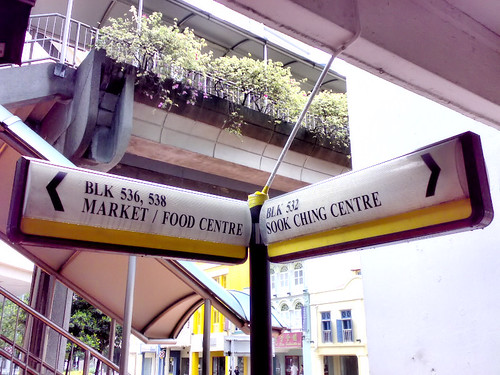
I'm not joking.
This picture was taken today opposite China Square Central. You may have visited the food centre before; I have tried their prawn noodle and fried char kway teow. But a Sook Ching Centre?!
Sook Ching (肃清) - purge through cleansing - was the systematic extermination of hostile Chinese by the Japanese military during the Japanese Occupation of Singapore. It was at such a place, a mass-screening centre, that local Chinese, innocent or not, were chosen to be massacred. If such a place still exist today, 63 years after the occupation, you'd avoid the place at all cost.
Whoever approved the direction sign should be shot, Sook Ching style. How can one mix up direction to a historical site with direction to a local amenity? I'm pretty sure historical sites have their own unique direction signs. You may have seen them in the city area. They tell you unambiguously the direction to a historical site and some even indicate the walking distance. They are also located in the open and not like the one in picture - you can see the tip almost touching the ground floor ceiling.
The historical site in question is the Sook Ching Centre at the corner of Cross Street and South Bridge Road. There used to be a monument marker near the road junction, but today the whole area was fenced up and I could not find the marker from the small opening behind the traffic light. I guess the marker was temporarily removed to facilitate the construction work going on.





